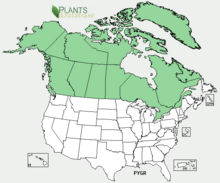Pyrola grandiflora
| Pyrola grandiflora | |
|---|---|
 |
|
| Scientific classification | |
| Kingdom: | Plantae |
| (unranked): | Angiosperms |
| (unranked): | Eudicots |
| Order: | Ericales |
| Family: | Ericaceae |
| Genus: | Pyrola |
| Species: | P. grandiflora |
| Binomial name | |
|
Pyrola grandiflora Radius |
|
 |
|
| Range of P. grandiflora in North America | |
Pyrola grandiflora (![]() pronunciation (US) , the largeflowered wintergreen, is a hardy perennial evergreen subshrub in the Ericaceae family. It is widely distributed in the Northern Hemisphere from temperate to tundra-like climates.
pronunciation (US) , the largeflowered wintergreen, is a hardy perennial evergreen subshrub in the Ericaceae family. It is widely distributed in the Northern Hemisphere from temperate to tundra-like climates.
According to A. E. Porsild in 1939, there are three recognized varieties of Pyrola grandiflora that includes var. canadensis, var. gormanii, and var. grandiflora which slightly differ in terms of leaf and floral morphology, fragrance, and habitat. For example, P. canadensis Andres are found in the southern lowlands and are taller and often have smaller flowers than normal.
Pyrola grandiflora is found throughout the Northern Hemisphere and is circumpolar including places: Greenland, Canada, United States, Alaska, Yukon, Northwest Territories Islands, Continental Northwest Territories, Nunavut Islands, Continental Nunavut, Northern Quebec, Eurasia, and the Arctic.
According to the Köppen climate classification, Pyrola grandiflora grows in certain types of climates: hemiboreal, taiga, and tundra found in the North Hemisphere or circumpolar. This perennial subshrub is able to grow on numerous substrates (surface in which an organism grows) on alpine tundra, heathlands, coniferous forests, boreal forests (taiga), woodlands, slopes, ridges, dry meadows, stony places and imperfectly drained moist or dry areas. Additionally, on humus in shrubby tundra, it is able to grow along with Vaccinium uliginosum, Salix alaxensis, Betula glandulosa. Flowering season is often between April to June.
...
Wikipedia
